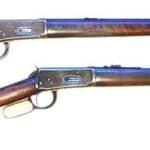
The Mauser Model 98, also known as the Gewehr 98, is a remarkable piece of firearms history. The rifle, widely respected and admired, represents one of the most recognized and influential firearms designs in the world. The Mauser 98 is more than just a historical firearm; it is a symbol of the evolution of firearms and has had a profound impact on global military history.
Development and Predecessors of the Mauser Model 98
The Model 98 was not born in a vacuum; it represents the culmination of various preceding designs, most notably other models from the Mauser family of rifles. The genesis of the Mauser rifle can be traced back to the Mauser Model 1871, a single-shot bolt-action rifle adopted by the German Empire.
However, it was the Mauser Model 1889 that represented a considerable step towards the final 98 design. This model introduced a box magazine, albeit a non-detachable one. Mauser continued to refine the bolt action design in models such as the Model 1893 and Model 1895, but it was not until the Model 1898 that all these improvements coalesced into one rifle that became the standard issue for the German army.
The Mauser Model 98, developed by the Mauser brothers, Paul and Wilhelm, was formally adopted by the German Army on April 5, 1898. The brothers successfully combined all the best features of their previous designs with some new innovations to create a masterpiece.
Manufacture of the Mauser Model 98
The primary manufacturer of the Model 98 was the German company Mauser AG Oberndorf. The original design was patented by Paul Mauser, but after his death in 1914, the company continued to produce the Model 98 under the guidance of his brother, Wilhelm.
Other firms that produced the Gewehr 98 during World War I include Deutsche Waffen- und Munitionsfabriken (DWM), Waffenfabrik Mauser Oberndorf, Imperial Arsenals of Amberg, Danzig, Erfurt, and Spandau. The combined total of Model 98 rifles produced by all these factories is difficult to ascertain, but estimates suggest that more than 14 million were made for the German military during World War I and II.
Use of the Mauser Model 98
The Mauser Model 98 served as the primary service rifle for the German Army during both World Wars. It saw service in all theaters and under all conditions, from the trenches of the Western Front in World War I to the vast Eastern Front in World War II. Despite its age, it was regarded as a reliable and robust firearm, able to withstand harsh environments and maintain performance.
Though the Mauser 98 was primarily a German weapon, it was also used extensively by other countries. Many nations purchased the rifles directly from Mauser, while others acquired licenses to manufacture their own. These include countries like Turkey, Czechoslovakia, Poland, and Yugoslavia.
The Model 98 did not see extensive use by the United States, as the US military primarily relied on the Springfield Model 1903 and the M1 Garand. However, the 1903 Springfield's design was significantly influenced by the Mauser, to the extent that the US Government had to pay royalties to Mauser for patent infringement.
Cartridges and Performance of the Mauser Model 98
The primary ammunition used by the Model 98 was the 7.92×57mm Mauser cartridge, known in military parlance as the 8mm Mauser. This round provided the rifle with an effective range of about 500 meters, which could be extended to 800 meters when
used with a telescopic sight.
The 8mm Mauser cartridge was notable for its relatively high velocity and flat trajectory, making it an effective cartridge for long-distance shooting. It was particularly suited for use in the bolt-action Mauser 98, which had a reputation for accuracy and durability.
Comparison with Other Battle Rifles
The Mauser 98 was in service around the same time as several other notable battle rifles. On the Allied side during World War II, the main competitors were the British Lee-Enfield, the American M1 Garand, and the Soviet Mosin-Nagant.
The Lee-Enfield, like the Mauser, was a bolt-action rifle, but it featured a 10-round magazine compared to the Mauser's five rounds. It was also noted for its high rate of fire. The M1 Garand, meanwhile, was a semi-automatic rifle with an eight-round capacity, providing a significant advantage in fire rate over bolt-action designs. However, both rifles acknowledged the Mauser's superior range and accuracy.
The Soviet Mosin-Nagant was another bolt-action rifle that was comparable to the Mauser. It was renowned for its ruggedness and simplicity but lacked the Mauser's refinement and precision.
Conclusion
The Mauser Model 98, with its sophisticated design and remarkable performance, has left an indelible mark on the annals of military history. Despite its age, it continues to be a symbol of German engineering and a testament to the evolution of firearms. Even in the 21st century, the Mauser 98 remains popular among collectors, hunters, and shooting enthusiasts, a testament to its enduring quality and appeal.
Discussion groups can be found here:
If you know of any forums or sites that should be referenced on this listing, please let us know here.




